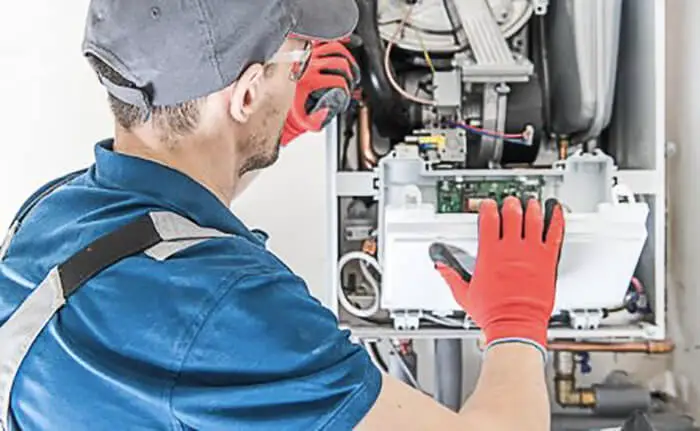A furnace is a heating unit that is used to increase the temperatures of an entire building. Furnaces are usually used as the main components of the primary heating stems. An average household spends approximately $2500 on energy bills annually. Almost half of the energy bill goes into heating and cooling expenses. The maintenance of furnaces can help reduce or save on energy costs, enhance the home’s overall comfort, and fight global warming. Maintaining the efficiency of furnaces is a great way to minimize repair costs as well as utility bills. Several things and techniques can help boost the overall efficiency of heating equipment without spending an extra charge. Keep on reading to discover five tips on how to increase the efficiency of your furnace system.
Having regular check-ups of your furnace is necessary to ensure its maximum efficiency.
1. Maintain Your Equipment
Neglect and dirt particles are the number one threats to heating systems that cause inefficiency and failure. To ensure efficiency, it is necessary to perform routine maintenance of the heating system. To start with, changing the filter frequently prevents dirt and dust from building up. The HVAC system traps dirt and dust before it is circulated through the heating system and to the rest of the house. According to Vaughan Smile HVAC the build-up clog will strain the furnace, making it difficult for air to be distributed through the home. The build-up dirt can reduce the performance of a furnace leading to early failure. When the filter is clogged and cannot blow air, the house will remain cold even though it is running. Therefore, it is necessary to clean or replace filters to ensure utmost efficiency continually. Secondly, it is advisable to regularly check the filters, especially during the summer and winter months.
Additionally, it is necessary to change the filters at least every three months. Also, proper maintenance by a technician is the key to reducing future problems. Planning for regular check-ups by skilled technicians will help reduce system failure. Furnaces are most important during the winter months, and system technicians are most busy during winter. Therefore, hiring a qualified technician will be a great start.
2. Use a Programmable Thermostat Properly
People who are out of their homes during specific periods of the day or weeks can purchase a programmable thermostat for their furnaces. A thermostat can be pre-programmed to suit one’s schedule. A programmable thermostat can be reduced to 10 degrees when no one is at home. It can then be scheduled to run just before waking up or getting back from work or school. Proper use of a programmable thermostat can help save approximately $200 used on energy systems annually. To determine the right thermostat model, it is essential to consider one’s schedule.
- A seven-day model is fit for families whose daily schedule keeps changing; for instance, some family members are at home earlier on certain days of the week. The seven-day model allows flexibility and permits various program settings for different days. The model has four temperature periods for each day.
- The 5 and 1 model are suitable for families with fixed schedules from Monday to Fridays, then Saturday through Sunday.
- The 5 and 2 model are suitable for families who have a weekday and weekend schedule.
3. Seal Your Heating and Cooling Ducts
Ducts distribute air all over the houses that have forced-air cooling and heating systems. In typical homes, approximately 30 percent of the air moving through ducts is lost due to holes, poorly connected ducts, or leaks. Therefore, these results in an inefficient HVAC system, increased utility bills, and difficulty keeping the houses comfortable.
Since the ducts are usually concealed in basements, walls, attics, and ceilings, repairing them can be tasking. However, there are a few things to do that can increase duct performance in houses. Sealing leaks using a metal foil or a mastic sealant and insulating the accessible ducts like the ones in the attics, garage or basements, can be a good start. Additionally, avoid using duct tapes as they are not long-lasting. Further, ensure that the connections at registers and vents are sealed correctly.
4. Seal and Insulate Your Home Envelope
The exterior of a house, including the ceilings, walls, windows, outer walls, and the floor, is called the shell or the envelope. With the help of a qualified technician, sealing and insulating the home envelope’s exterior can reduce annual energy costs to up to 10%. Insulating and sealing will also make a home more comfortable. Sealed and insulated houses ensure that heat from the furnace is not lost through leaks.
It is advisable to look and seal any air leaks before installing furnaces because it is most effective when the air is not moving around or through it. Most leaks, especially around windows, are easy to find and feel. However, leaks in the basements, attics can be more significant problems. Sealing the leaks using spray foam will significantly improve the efficiency of the heating system.
5. Choose the Right Equipment
The right choice of equipment is the basis for efficiency and effectiveness. Faulty or limited equipment will not be efficient even after following all the above tips. Purchasing the right furnace from a reputable company ensures that the equipment is sufficient and will not spoil after some time. Most companies have a warranty for the equipment. Therefore, one can replace the furnace in case of a malfunction. It is necessary to replace a furnace after a couple of years or if the furnace is not working as expected. Low-efficiency units spoil within a few months of use. Some equipment saves energy use while others over consume it. Therefore, before purchasing any heating unit or furnace, it is necessary to do prior research on the equipment, and it is even better, to have a professional suggest the best choice for you.

